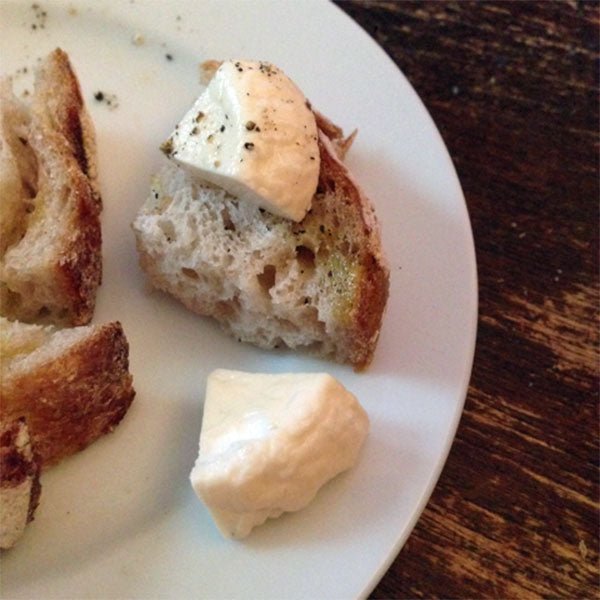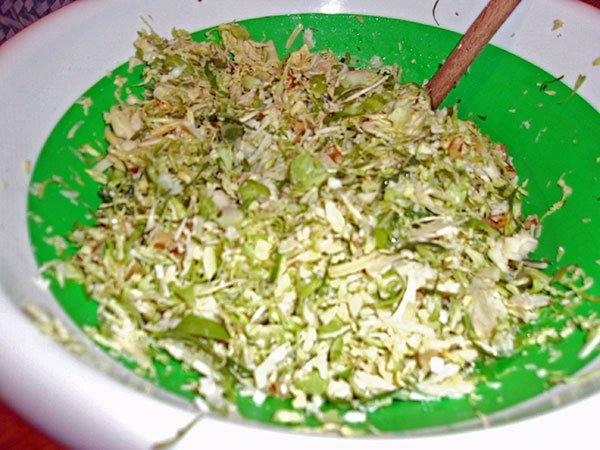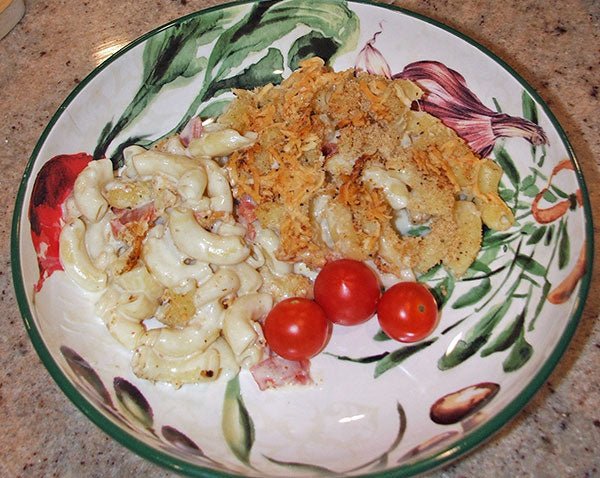
Michael in Malta. He told us he doesn’t get to go there nearly enough.
Michael Calleia (calleia.com) is a Maltese-American enjoying life with his wife and child. When not cooking with his daughter, Michael can be found at his company Humanist (humanist.co), a strategy and design practice that partners with companies to build digital products people want and brands they love.
A few months ago, Michael sent us a question about his Gbejna and we asked him to share the recipe with us. He not only did that, he researched the cheese and sent us this fabulous article with everything you could possibly want to know about these tiny little cheeselets. We are very grateful.
Gbejna, Maltese Cheeselets
By Michael Calleia
One of the great joys of parenthood is sharing and passing on family and cultural traditions. For many, sharing the foods of their forebearers is as simple as a walk to the local grocery or the corner restaurant. But for some, it can be a little more of a challenge.
 In the case of my daughter and I, a good number of our own forebearers are from a group of tiny islands in the middle of the Mediterranean Sea that make up the E.U. country of Malta. While we can make many of the foods I grew up with and know as Maltese—there are a few that are a little harder to recreate. A number of dishes need a unique Maltese cheese—the small cheeselets called Gbejna (pronounced, gib-ane-ia).
In the case of my daughter and I, a good number of our own forebearers are from a group of tiny islands in the middle of the Mediterranean Sea that make up the E.U. country of Malta. While we can make many of the foods I grew up with and know as Maltese—there are a few that are a little harder to recreate. A number of dishes need a unique Maltese cheese—the small cheeselets called Gbejna (pronounced, gib-ane-ia).
By way of a brief introduction, Malta has a very long and diverse history—being home to the oldest standing stone structures in the world and one of the most concentrated historic areas in the world. Malta has been passed from one power to another for centuries—having been possessed by the Greeks, Romans, Byzantines, Normans, and so on.

From educatouring.com
For a period, Malta was part of Italy, or more specifically The Kingdom of Sicily until 1530 when Charles I of Spain, as King of Sicily, gave the country of to the Order of Knights of the Hospital of Saint John of Jerusalem (later called the Knights of Malta). More recently, during WWII Malta played a pivotal role for the Allies, became independent in 1964 and finally joined the E.U. in 2004. A more detailed history of Malta can be found here. (https://en.wikipedia.org/wiki/History_of_Malta).

Butternut squash with Gbejna from Good Food Everyday
Culturally, the country is European and Malta’s food is typical Mediterranean fare, with clear influences from Southern Italy and North African (more about the cuisines of Malta (https://en.wikipedia.org/wiki/Maltese_cuisine). In fact, many of the foods of Malta are similar to Southern Italian dishes, but yet a little different.

An assortment of Gbejna from I Love Food
Since we cannot purchase Gbejna in the U.S. and there is nothing available that is quite like it, my 5 year old daughter and I decided to take up the challenge to make it ourselves. We found a few recipes, but they were mostly based (or cut and pasted) from one source, optimized for making due in a bygone pre-Internet when the ingredients would have been harder to come by.
So, we had to come up with a new recipe. To do this, we did lots of research; we looked for similar cheeses made in Sicilly and Southern Italy and how they are made, studied the packaging of mass produced Gbejna and corresponded with their makers, looked at how Maltese farmers traditionally make Gbejna and reached out to farmers there.

Maltese Cheese Pastizzi from Trip Advisor
So what makes these little cheeselets so different?
Gbejna (plural gbejniet) are traditional cheeselets produced from sheep’s or goat’s milk using rennet to set the curds. In Matla, Gbejna is used for filling ravioli, the national baked good called Pastizzi, can be found topping pizza, used to grate over pasta, with some fresh Maltese bread (“If you could judge a country’s wealth from its bread, Malta would have to be the richest,” says Duran Duran’s bass guitarist John Taylor) and some olive oil (which Jamie Oliver sang the praise of http://www.jamieoliver.com/news-and-features/features/maltese-olive-oil-worlds-best/), in soups, and more.
Perhaps the most amazing thing about this cheese (besides how easy it is to make) is how many different variations of this tiny cheese exist. How can one cheese be used for so many things? It all depends on if the cheese is fresh or how much it has been dried, if it has been peppered, or preserved in vinegar, olive oil, or a mix of both.

Varieties of Gbejna from cheesewiki.com
Some of the varieties of Gbejna include:
Gbejna Friska: the fresh soft version
Gbejna ta’ l-ilma: fresh, stored in its whey
Gbejna Mahsula: salt cured in brine of salt and water
Gbejna Moxxa (niexfa, bajda or t’Ghawdex): dried Gbejna
Gbejna Tal-Bzar: the sharper and harder textured pepper cured version

You can see how tiny these little baskets are in this photo from In Cucina Con Mirka
Equipment and cheese terms in Maltese:
Gobon: cheese
Gbejna: the diminutive form of Gobon, meaning a cheeselet
Qaleb (plural “qwieleb”): cheeselet forms or baskets. Traditionally made from reed, these are now made from plastic. The size is about 2″ diameter at base, 2.5″ wide and 2.75″ diameter at top
Qannic or Nemusiera (Q in Maltese is a soft guttural stop): Specially-constructed wooden cages covered with a net to air-dry Gbejna outdoors
Baqta: curd
Xerox (X in Maltese is pronounced like “sh”): whey

Goats milk from local Farmers’ Market, Lynnhaven (http://www.lynnhavennubians.com); rennet, calcium chloride and cheese salt from New England Cheesemaking Supply Company
Milk source
Gbejna tan-naghag: Gbejna made with sheep’s milk. The traditional milk source for Gbejna in Malta
Gbejna tal-moghoz: Gbejna made with goat’s milk
Gbejna can also be made from cow’s milk
How simple is Gbejna to make?
We were a little surprised just how simple it was. Joe Spiteri, a farmer on the Maltese island of Gozo (tamena-gozo.com), shared how Gbejna is traditionally made. Basically, you milk your sheep in the morning, pour the still warm milk through a strainer, mix in rennet (many of the farmers still uses natural rennet they make from the dried stomach of a lamb), wait about an hour, pour into Qaleb (baskets), sprinkle salt over the cheese, let sit, flip once, salt again, let sit, and done. Seriously, that is it, no heating, no stirring.

This is actually a drying box from Mexico, photo courtesy of Dirt and Dogs
If you are going to dry the cheese, you do so outdoors (not in direct sunlight) in a netted cage called a Qannic. Simple right? But, living in a city in the U.S., we had to make a few adjustments.
The biggest challenge to making Gbejna at home will likely be finding Qaleb, the cheese forms. Lucky for us, we have a set of these baskets that belonged to my mother—she brought them back after a trip to Malta—and one day they will be my daughters.
Here is our recipe for making Gbejna:
Ingredients
1 gallon sheep’s or goat’s milk. We used goat’s milk from Lynnhaven (http://www.lynnhavennubians.com), a goat dairy that sells at our local famers’ market
1/4 tsp. calcium chloride diluted in 1/4 cup of cool, non-chlorinated water. Our milk was bottled just a day before use, but was pasteurized, so we added calcium chloride from New England Cheesemaking Supply Company (cheesemaking.com) to help firm up our curds. If your milk is pasteurized this will help your curds.
Rennet: 1/4 tablet (Fromase 50, not junket), 1/4 tsp. liquid animal rennet, 1/8 tsp. vegetable rennet in 1/4 cup of cool, non-chlorinated water. We went with vegetable rennet from New England Cheesemaking Supply Company since we have a vegetarian in our household.
1.0–1.29g salt (non-iodized) per cheeselet. We have 18 cheese baskets, so ~18–24g. We used cheese salt from New England Cheesemaking Supply Company.
Process
Before starting, make sure your utensils, pot and all surfaces are clean. We dropped everything we could into the pot we planned to use, added some water to cover the bottom and boiled to sterilized. We boiled the baskets very lightly for fear of melting them after spraying with vinegar and water. Whatever can’t be boiled, should wiped down with a mixture of vinegar and water.

Prep. We cleaned the baskets with a mix of vinegar and water, then put them in a covered pot with some boiling water. We did not leave them as long as our metal utensils so we would not melt the baskets.
Put the milk in a pot and heat to 90–95° F. Stir while heating so the temperature is uniform.

Pouring the milk

Heating the milk
Remove from heat and add the rennet. This is also the time to add calcium chloride if needed.

Measuring the rennet

Pouring the rennet
Cover and leave undisturbed for 45 min–1 hour.

Setting the curds
Scoop the curds into baskets. Place the baskets on a draining pan. We used a wire drying rack over a cookie sheet.

Scooping the curds into baskets
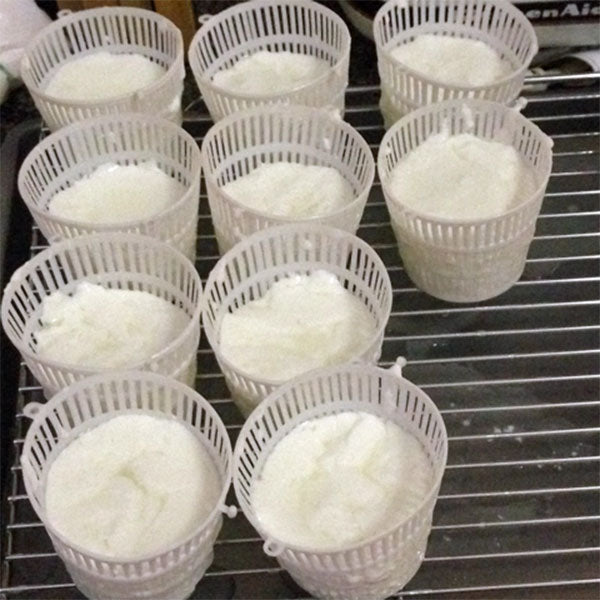
Filled baskets
Sprinkle each basket with salt to help remove liquid. This helps to preserve your cheeselets.

Salting
Let sit in the refrigerator for 6 hours to set.
Drain water from the pan as needed.
Flip the cheeselets. Take one basket at a time, turn the cheese into the palm of one hand; now transfer it to the other hand and replace it in the basket so the side with the imprint is facing up.

Flipping—the distinctive pattern found on Ġbejna
Sprinkle each basket with salt again.
Let sit in the refrigerator for 4–6 hours.
Remove the cheese from the baskets. You now have Gbejna Friska, ready to be eaten with bread or in soup, or ready to be transformed through drying.
If you plan on eating them fresh, then keep your cheeselets refrigerated. You can store them in whey (if you retained) or a brine (just don’t add too much salt).
We ate some of the fresh cheese with Hobz biz-zejt, bread and olive oil (https://en.wikipedia.org/wiki/Maltese_bread), and made Ravjul with a few more.
The rest of our cheeselets were reserved for experimentation with different drying methods.
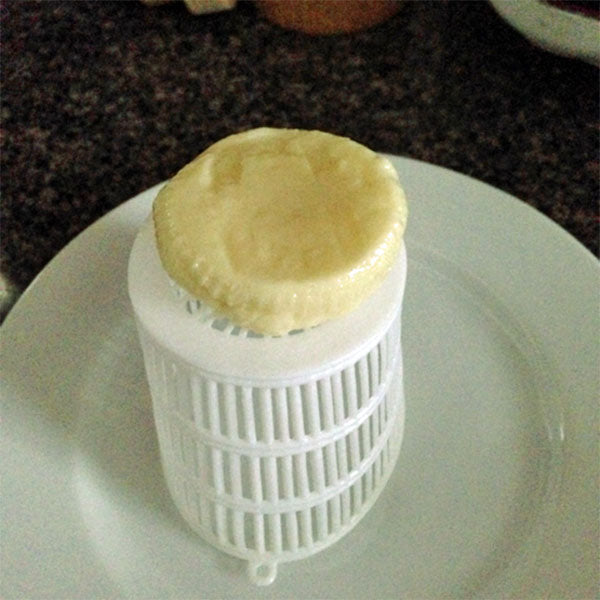
Drying, one week on the counter (under a net)
Drying Gbejna
As mentioned, making Gbejna is fairly easy, but my wife and I had concerns about drying the cheese by leaving it out on the kitchen counter for days. To mitigate our fears, we practiced good cheese making hygiene, cleaning all surfaces and tools, purchased a picnic net to keep our cheese safe on the counter, salted the cheese, and gave our dried cheese a traditional bath in vinegar (thanks to Joe Spiteri for that last tip). In the end, drying the cheese was a lot easier than we expected.
We experimented with drying our cheese on the counter and in the refrigerator. The refrigerator took about twice as long to dry the cheese. In the end, I liked the ones dried on the counter best.
Process
Place cheese on a rack or upside down cheese baskets under a net (we used a picnic table net).
Drain water from the pan or plate as needed
Turn your Gbejna about twice per day (we flipped them in the morning and at night, be sure the wash your hands carefully before touching the cheese)
Drying will take about eight to twelve days to dry, depending on humidity, temperature and how much hard you want them. For peppering and pickling you want them to be semi-hard, for grating much harder.
Once you are finished drying your cheese put them in a jar filled with white vinegar for 24-hours.

Pickled in vinegar and pepper
Pat dry and proceed as you desire.
If you plan on pickling them (I know pickling cheese sounds weird right, but it is going in vinegar, so if it isn’t pickling what is it?) place the cheeselets in a jar and cover with white wine vinegar, olive oil or a mix of the two. This gives the cheese a piquant flavor and a crumbly texture.
As the cheese dries, it will slowly stop draining. By day two or three, it will start to feel rubbery and on day three or four it will start to darken and turn off-white. You may see some oils expelled after that (we just patted them dry with a paper towel once a day). On day four or five it will start to feel dry with some oil still expelled on the edges and should smell like cheese when you smell it up close. Obviously, if something seems off to you, if you have any doubts, just toss it — you can always make more another time.
In our case, we grated one cheeselet on pasta—it was similar to a young Pecorino Romano. The rest we pickled in white wine vinegar and pepper for a few more days and then enjoyed with bread.

Dried (we grated this one over pasta)
It was great being able to share in the adventure of making this cheese and enjoying it in so many different ways with my daughter.

Pickled Gbejna on bread
Additional notes
From our research somewhat similar cheeses from Sicily and Italy are: Cacioricotta, Caprino Fresco, Tuma, and Primosale. One major difference is that all of these cheeses are made in much larger baskets. We also could not find any Italian cheese preserved in vinegar or olive oil—though I do not doubt this might be done someplace in Italy.
The other Maltese cheese, irkotta is also made from sheep’s milk, but uses seawater rather than rennet. This cheese uses a larger basket. Unlike Italian Ricotta, Maltese irkotta is traditionally made with whole milk rather than leftover whey. Though, today it is commercially made from either or a combination.

Maltese Irkotta looks exactly like Italian Ricotta, although they are made differently (from Malta Today)






























